What is a snare pole and how to use it
When trapping and releasing a wild Louisville animal near your home, it’s best to leave it to professionals. They know how to hurt neither themselves nor the animal, and they can transport it to a safe place.

Of course, you don’t always have that option. And if the day comes when you need to catch a wild animal yourself, you’ll need to follow a few simple rules – don’t get bitten, don’t lose control of the animal, and don’t panic.
For every one of those rules, no tool is better than a snare pole. It’s easy to use, buy, or build, and it fulfills every requirement listed above – provided you use it properly.
Snare poles are devices you’ve likely seen before – a long pole with a loop of wire or rope attached to the end, which loops back through the pole to the handle. You hold the end of the pole, and pull the loop tight when an animal wanders through it. It’s a simple design. Executing a catch, however, isn’t that simple.
First, understand a snare pole’s purpose – it’s meant to subdue, not kill, the animal. A quality pole leads to humane captures. Don’t get a cheap model, and don’t build one with cheap materials. You can build a snare pole yourself, but the time and effort you put into it might end up costing you more than simply buying one wholesale. The internet has plenty of tutorials on building snare poles, but know your limitations here – if you don’t have the patience to do it right, you and your target animal are better off with you buying one. They cost somewhere between $40 and $130 apiece.
Second, make sure you know the Kentucky animal you’re snaring. The whole point of the pole is to prevent injury. If you’re trapping a muskrat with a short pole, you’ve no problem; if you’re trapping a gator, you’re in serious trouble. If you’re trapping a feral cat, it might choke itself unless your pole has a swivel. Get the pole that’s meant for your particular pest.
Third? Have patience, and lots of it. Snare poles work by surprising the Louisville animal. You might be sitting a while, so be prepared to wait – or prepared to scare the animal out of its lair. Once it wanders in your loop, pull your end tight, and lift as much as you can.
The first time you snare a Kentucky animal, your tendency might be to give it too much slack. Don’t. The animal will slip away if that happens. You’ll have plenty of warning if you’re choking your target, but little to no warning if your target slips away.
If you’re dealing with a cat, take care, because those Louisville animals will choke themselves easily before they calm down. Aim for the torso, and, as mentioned, get a pole with a swivel.
Your goal is to tire the animal out, and relocate it. Have a cage ready, and make sure you destroy the den.
Visit our Louisville wildlife trapping home page to learn more about us.

